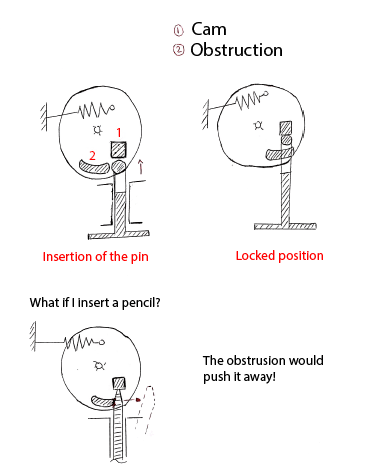Concept
To solve the actual problem we found out two possible guidelines: to deny the access of any external tool (different from the pin) or to allow its inserting without it damaging the system.
These two opposite philosophies brought us to develop two different models of self-repairing doorlock.
The team, before defining a main and a secondary system, worked on both the projects, designing their CAD features with advanced features.
Here are shown the concepts from which the team began modelling.
Full Access Model
The main idea follows the most accomodating of the two. The model allows the entrance of any object but manages to get to the locking position only with its pin inserted (because of the hole top-bottom).
In this model the blocking cam raises everytime an external object is inserted; the spring on its bak, though, tries to bring it back to its equilibrium position. The key of the system is the cavity in the cam: its shape has been created by copying the front face of the pin, so that the mechanism could lock.

(Sketch of the concept for the Full Access model: insertion of its own pin)
In case an external component is inserted, the cam will raise as before but, it would not find a cavity where to set. As soon as the inserted object is removed the cam will come back to its initial condition.

(Sketch of the concept for the Full Access model: insertion of an external object)
Barrier Model
The alternative is a consequence of the opposite idea: to deny the access of any external object into the mechanism,
As it can be seen from the sketch if an external object is inserted it would be pushed out by the obstruction (piece 2)
The shape of this last piece is not random but represents the relative motion among the pin and the cam during the rotation. By doing this the access is granted only to a specific component with a particular shape: the pin itself.

(Sketch of the Barrier model: only its pin is allowed to enter)
Laboratorio Progettuale CAD - Academic year 2015-2016

